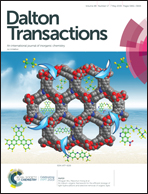Metal–organic framework assisted and in situ synthesis of hollow CdS nanostructures with highly efficient photocatalytic hydrogen evolution†
Abstract
Here, hollow CdS nanoboxes (average size of 120 nm) with graded nanovoids (ranging from 2 nm to 13 nm) distributed in the walls (average thickness of 20 nm) are in situ synthesized through directly sulfurizing a Cd metal–organic framework (Cd-MOF-47) with thiourea. A specific surface area of 153 m2 g−1 is achieved. With as-prepared hollow CdS nanoboxes as photocatalysts for water splitting to H2 (visible light irradiation), H2 evolution rate is as high as 21 654 μmol g−1 h−1, which is nearly 79 times higher than that of bulk CdS. Such an excellent photocatalytic efficiency is ascribed to the large specific surface area for improving light absorbability and the porous nanostructure for efficiently utilizing excitation light due to the multiple scattering within the hollow framework. Moreover, a smaller band gap (2.30 eV) with a higher conduction band (−0.83 V) presents a strong reducibility, which is beneficial for reducing H2O to H2. A combination of fluorescence spectroscopy (PL), PL lifetimes and the photoelectrochemical technique shows that hollow CdS nanoboxes exhibit lower fluorescence intensity, longer electron lifetime and stronger photocurrent intensity than bulk CdS, implying an improved separation and transfer of photoinduced charge carriers. This work presents a novel methodology to prepare hollow nanostructures, exhibiting potential applications in the field of energy conversion.



 Please wait while we load your content...
Please wait while we load your content...